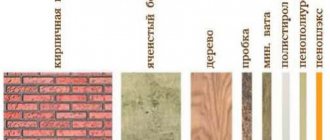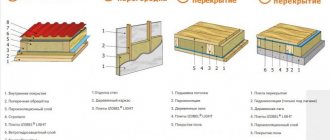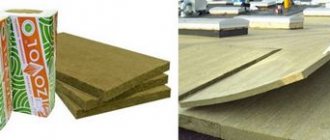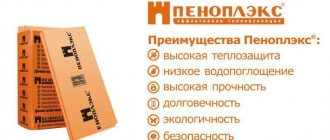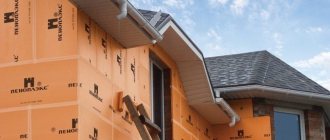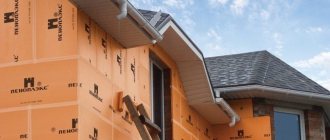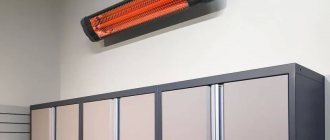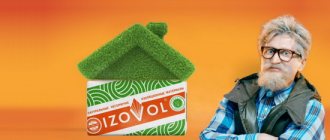Penoplex is a building heat-insulating material in the form of slabs of extruded polystyrene foam, in demand due to its lightness, strength and durability. In structure, it is similar to the usual polystyrene foam, but is more dense.
The barely visible pores of the insulation, measuring from 0.1 to 1 mm, are the result of new manufacturing technologies. In appearance, the slabs consist of a homogeneous material, which is actually finely porous with insulated cells, providing low thermal conductivity and water resistance.
A variety of grades and enhanced strength allow it to be used for insulating floors, roofs, and foundations.
Types, technical characteristics and purpose
Since 2011, product differentiation has been introduced depending on the purpose and area of application. This allows you to quickly find out the type of insulation you need with a set of characteristics for a specific type of work and promotes maximum efficient use.
Several types of extruded polystyrene are available:
WALL, or penoplex 31 with fire retardants
Designed for insulation of surfaces without dynamic or static load. Optimal for insulating facade walls, partitions, swimming pools, wells, heating networks, water supply systems.
Characteristics:
| Properties | Unit | Index |
| Thermal conductivity, 25°С | W/(mK) | 0,03 |
| Density | kg/m3 | 25,0–32,0 |
| Strength | MPa (kgf/cm2; t/m2) | 0,20(2,0; 20) |
| Water permeability, 28 days | % by volume | 0,5 |
| Fire protection | group | G3 |
| Working temperature | С° | from -50 to +75 |
FOUNDATION, or penoplex 35 without fire retardant
The slabs are designed for heavy loads and are durable. Ideal for road surfaces, foundations, floors, and basement equipment. The presence of a waterproofing barrier allows groundwater to be drained from the underground part of the house.
Characteristics:
| Properties | Unit | Index |
| Thermal conductivity, 25°С | W/(mK) | 0,03 |
| Density | kg/m3 | 29,0–33,0 |
| Strength | MPa (kgf/cm2; t/m2) | 0,27 (2,7; 27) |
| Water permeability, 28 days | % by volume | 0,5 |
| Fire protection | group | G4 |
| Working temperature | С° | from -50 to +75 |
ROOFING, or penoplex 35
The slabs are designed for insulation of roofs and attic spaces of any type, taking into account climatic precipitation and temperature changes. Currently, it is used for flat roofs with winter gardens or parking lots placed on it (inversion roofing).
Characteristics:
| Properties | Unit | Index |
| Thermal conductivity, 25°С | W/(mK) | 0,03 |
| Density | kg/m3 | 28,0–33,0 |
| Strength | MPa (kgf/cm2; t/m2) | 0,25 (2,5; 25) |
| Water permeability, 28 days | % by volume | 0,5 |
| Fire protection | group | G3 |
| Working temperature | С° | from -50 to +75 |
COMFORT, or penoplex 31C
Universal slabs are suitable for insulating loggias, balconies, walls and floors of saunas, and mansions. It is characterized by increased moisture resistance and provides an optimal microclimate. Due to technical features, slabs of this type are particularly tightly adjacent to each other.
Characteristics:
| Properties | Unit | Index |
| Thermal conductivity, 25°С | W/(mK) | 0,03 |
| Density | kg/m3 | 25,0–35,0 |
| Strength | MPa (kgf/cm2; t/m2) | 0,20 (2,0; 20) |
| Water permeability, 28 days | % by volume | 0,5 |
| Fire protection | group | G4 |
| Working temperature | С° | from -50 to +75 |
Penoplex 45
It is used for thermal protection of take-off surfaces and roads, protects against subsidence, deformation, and swelling of the canvas. Designed for heavy loads: can withstand the weight of an aircraft in regions with low temperatures. The strongest material retains its properties for a long time.
Characteristics:
| Properties | Unit | Index |
| Thermal conductivity, 25°С | W/(mK) | 0,03 |
| Density | kg/m3 | 35,0–47,0 |
| Strength | MPa (kgf/cm2; t/m2) | 0,50 (5,0; 50) |
| Water permeability, 28 days | % by volume | 0,4 |
| Fire protection | group | G4 |
| Working temperature | С° | from -50 to +75 |
Types of insulation boards
We insulate the floor on the balcony
Since there are plenty of varieties of penoplex on the construction market, manufacturers produce it with specific names that allow you to speed up the selection process. Let's look at these types:
- Penoplex “roofing” - the density of roof insulation slabs is 28-33 kg/m3. Lightweight and waterproof
- “Wall” - can be used for both interior and exterior work. The density of the material is 25-33kg/m3
- “Foundation” - high density and water resistance allows the material to be used during the construction of a foundation or basement. Density – 29-33kg/m3
- “Comfort” - slabs are used for balconies and apartments, as well as uninsulated loggias. Density – 25-35kg/m3
- Penoplex “45” - this material has the highest density among others, which is 35-47 kg/m2. This is why it is used during the construction of roads and runways.
Article on the topic: Art Nouveau style in the interior
For the average consumer, I have compiled a table of the estimated cost of penoplex. Thanks to it, you can make approximate calculations of the required amount to purchase material of different thicknesses:
| Name | Thickness | Area/volume per package. m2/m3 | Sheets per package (quantity) | Cost of 1 package | Price for 1 sheet |
| PENOPLEX | 20 | 14,4/0,288 | 20 | 1 200 — 1 400 | 60-70 |
| 30 | 10,08/0,30 | 14 | 1 260 — 1 540 | 90-110 | |
| 40 | 7,2/0,288 | 10 | 1 200 — 1 400 | 120-140 | |
| 50 | 5,76/0,288 | 8 | 1 200 — 1 520 | 150-190 | |
| 60 | 5,04/0,30 | 7 | 1 260 – 1 274 | 180-182 | |
| 80 | 3,6/0,288 | 5 | 1 195 – 1 205 | 239-241 | |
| 100 | 2,88/0,288 | 4 | 1 200 – 1 240 | 300-310 |
Dimensions, thickness and cost
The stability of thermal insulation properties allows the use of slabs of medium thickness from 35 to 50 mm. This is average for a standard solution in a temperate climate.
Increased thickness of penoplex up to 70 mm or more is used in northern regions, where temperatures often drop to -300 C. This approach is justified, especially since the usual thickness of other insulation materials reaches 150 mm.
The dimensions of the slabs are standardized by the manufacturer to standard 1200 mm in length and 600 mm in width.
Compared to other types of insulation, the cost of penoplex is quite high: the price of 1 square meter of sheet is on average $5. If the material is modified with improved qualities, including fire retardant additives, then the price will be $7-8 per 1 sq.m.
MAIN LINE OF PRODUCTS PENOPLEX plant:
- PENOPLEX ROOF – used for thermal insulation of pitched and flat roofs;
- PENOPLEX WALL - used for thermal insulation of external and internal enclosing structures (walls, plinths, partitions, facade systems);
- PENOPLEX FOUNDATION - used in loaded structures with a protective layer (cement-sand screeds, foundations, floors);
- PENOPLEX COMFORT - used for thermal insulation of country houses or city apartments (insulation of walls, extensions, balconies, loggias).
Production technology and scope
The specifics of penoplex manufacturing are aimed at improving the strength and technical characteristics of the material.
It is given special properties by the process of extrusion from raw materials in special furnaces. First, polystyrene granules are mixed with a foaming agent under conditions of high humidity and temperature. The catalyst is a composition of carbon dioxide (CO2) and freon. The polystyrene foam composition is melted in ovens and resembles lush cream.
Then, through the extrusion installation, the substance begins to be squeezed out, the freon gradually evaporates, and the cells are filled with simple air.
The use of penoplex in the construction industry has practically no restrictions and, thanks to its technical characteristics, can significantly reduce the costs of other consumables and energy resources.
Currently, heat insulation is in demand in different climatic conditions for insulation and protection:
- foundations and walls of low-rise buildings;
- balconies and loggias;
- pools and wells;
- ceilings and basements;
- floors and ceilings;
- water supply systems;
- airfield runways;
- railways and roads;
Penoplex of various categories is widely used in the process of reconstruction of buildings due to its high resistance to environmental changes and chemical influences. The material is used to make sandwich panels.
What is Penoplex made of? Compound
We have before us a completely artificial material, which is made from chemical components mixed in certain proportions. The technology involves using a temperature of 140 degrees, which causes the ingredients to melt and foam, forming porophores. If we talk about specifics, the following materials are used in production:
The use of insulation in the construction of buildings significantly reduces heating costs in the winter and air conditioning during the summer heat.
Choosing the right thermal insulation is quite difficult. The market offers a huge number of rolled, bulk and tile insulation materials that do an excellent job of thermal insulation. Among modern and inexpensive means for insulation, the most popular is penoplex, which, among other advantages, can be independently installed in private construction.
What properties does insulation have, as well as how much penoplex costs and how to choose the most suitable block in size will be described in detail in the article.
Material properties
The main characteristics of the insulation meet the requirements of building regulations:
- Low thermal conductivity coefficient. The average level corresponds to 0.027–0.031 W/m. The indicator is the best in the class of insulation. At the same time, its difference from related materials, for example, mineral wool, is not so significant. But the combination of low thermal conductivity with increased structure density provides noticeable advantages. An important factor is the constancy of the indicator; significant fluctuations in different conditions are not recorded, therefore the use of penoplex is allowed without an additional moisture-proof layer both on roofs and attics, and on foundations, floors, and basements.
- Fire resistance. Fire resistance is characterized by categories G3 or G4, which means a moderate level that exceeds the properties of foam plastic that supports combustion. Operating temperatures from -50° to +70°C are acceptable for polystyrene foam. In open fire conditions, the material is destroyed. The melting process begins, but not combustion. Some types of penoplex are characterized by enhanced treatment with chemical reagents to exhibit self-extinguishing. This improved quality corresponds to complete fire safety under extended operating temperature conditions.
- Moisture resistance. Water absorption of extruded polystyrene foam is 0.4% of the volume over a period of 28 days. Moisture enters only into the external pores of the insulation, which are opened when cutting and installing the slabs. Closed cells are kept unchanged. In fact, it can be argued that the material does not allow moisture to pass through. For insulation of facades and roofs of buildings, such moisture resistance indicators are very significant.
- High compressive elasticity. This figure is 25-35 kg/m3 and is unsurpassed among polystyrene foam insulation. Compressive resistance is achieved through the uniform distribution of tiny cells with good adhesion, improving the strength characteristics of the material. Penoplex does not change dimensions even under heavy loads. The slabs are very difficult to break. Only material with a small thickness of 20 mm is subject to damage, but there is no crumbling or crushing along the fault line, unlike other related insulation materials.
- Weak vapor permeability. Increased resistance is reflected in equal indicators of penoplex with a height of 2 cm and a layer of roofing material.
- Long service life. The warranty period for use is 50 years, taking into account atmospheric exposure. Under favorable climatic conditions, the slabs will last much longer while maintaining all their characteristics.
- Environmental friendliness. The use of freon in the manufacture of insulation is absolutely harmless: this type is non-flammable, non-toxic, and does not cause destruction to the ozone layer. Environmental properties are interconnected with the biostability of the insulation and the absence of toxic substances. The material is not subject to biological decay, therefore it does not require special storage conditions; the slabs can be placed on sites without shelter from precipitation or temperature changes.
- Availability of installation and processing . You can cut the slab with a regular stationery knife. The low weight allows you to cover the walls yourself without additional effort in constructing special frames. The material adheres well to glue. Weather conditions do not interfere with installation.
- Resistance to aggressive substances. Most construction mixtures and preparations are not capable of damaging penoplex, which does not react with them. These include organic and inorganic acids, alkalis, water-based paints, salt solutions, ammonia, cement or concrete mixtures, alcohols and oils, bleach. Extruded polystyrene foam has virtually no chemical activity. Attention! The exceptions are ethers, gasolines, formaldehydes, and oil-based paints.
- High sound insulation. In private housing construction, the noise insulation factor is very important. Penoplex solves this problem.
What is penoplex
In order to properly perform insulation work with penoplex, you need to know about the basic technical capabilities of the material. Penoplex is a type of foam plastic that is significantly superior to its predecessor in many respects.
The basis of penoplex is polystyrene chips, which in a special chamber are exposed to high temperatures with the addition of substances that produce gas when heated. In this way, foaming of the molten polystyrene mass is carried out.
At the production stage, various plasticizers, light stabilizers, antioxidants and other fillers that improve strength and aesthetic qualities are added to the mixture. The final stage of penoplex production is its extrusion from the extruder, followed by uniform cooling on the transport belt. Where the material is shaped into a slab or block.
If extruded polystyrene foam was manufactured without violating the production technology, then the finished material will have a homogeneous structure with a cell size of less than 0.3 mm. At the same time, the amount of synthetic material should not exceed 2% of the volume of the finished product, the rest of the volume is the filler gas.
The most commonly used foaming gas is nitrogen or carbon dioxide. Both substances do not support combustion and are not toxic to humans.
Advantages and disadvantages
The positive features of insulation are manifested at all stages of use of this material:
- Lightweight slabs are easy to prepare and process and do not require special knowledge and skills to operate.
- They are attached in different ways and do not require additional layers of vapor and waterproofing.
- Excellent thermal insulation qualities allow you to save on other building materials.
- Durability and strength in any climate tests.
- Safety and environmental friendliness.
The disadvantages of the new generation material include:
- Susceptibility to attacks by rodents , which is typical for all types of insulation.
- Emission of acrid smoke when decomposed by open fire.
- Does not withstand combination with kerosene , gasoline or diesel fuel.
- Insufficient sound insulation compared to materials intended for this purpose.
- High prices for various types of penoplex, comparable to expensive mineral wool.
DIY installation
Installation of penoplex on the ceiling
Thermal insulation boards are fastened using a technology that is simple and accessible to everyone. Since I have already carried out insulation with my own hands more than once, I decided to describe all the stages by which the installation of penoplex takes place:
- Preparing the walls - at this stage, all stains of dirt and grease, as well as dust and old finishes, should be removed from the surfaces. If necessary, you need to use plaster mixtures to seal all cracks and obvious irregularities. In addition, the walls are treated with antifungal agents
- Before attaching penoplex, you should make a choice among fastening materials: you can use an adhesive solution that will be applied to the surface of the slab. It should be remembered that the surface of the walls must be completely dry. In addition, it can be applied using dowels. For 1 sq. meter should take 4 dowels, while at the corners of the house more fastening materials should be used
- When the thermal insulation is fixed, you should proceed to further steps on finishing the facades. Here you can use wet technology and use plaster compounds - for better strength you need to create additional roughness and use a reinforcing mesh
- For those who do not like the use of plaster for wall cladding, an option using siding, wood or another type of hanging system, which requires the installation of lathing, is suitable.
Related article: Coaxial cable Finmark F660BV
There are times when it is not possible to insulate the outside of the house. In this case. Penoplex boards are attached to the internal walls, after which they are covered with foil-coated polyethylene film and sheathed with gypsum plasterboard sheets. After this, you can carry out subsequent interior decoration of the rooms.
What is contact allowed?
The advantage of 50 mm penoplex insulation, among other things, is that it is resistant to various types of paints, mortars, acids and alkalis. For example, such boards do not collapse upon contact with butane, ammonia, animal and vegetable fats, alcohol and water-based paints.
Penoplex material is resistant to various chemicals. However, some such substances can still have a negative effect on it. These include, for example:
- gasoline and kerosene;
- tar;
- oil paint;
- epoxy resin;
- acetone and xylene;
- formaldehyde;
- toluene;
- formalin;
- diethyl alcohol.
